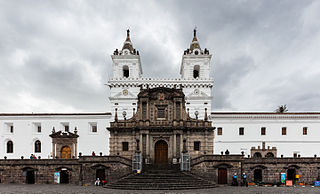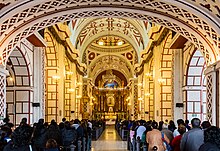
The basilica and the monastery of San Francisco de Asis were built in Havana, Cuba at the end of the sixteenth century (1580–91) as the home of the Franciscan community in Havana. The basilica was altered in 1730.

Churubusco is a neighbourhood of Mexico City. Under the current territorial division of the Mexican Federal District, it is a part of the borough (delegación) of Coyoacán. It is centred on the former Franciscan monastery (ex convento de Churubusco) at 19°21′20″N99°8′55″W.

Located principally in the city centre or Cercado de Lima and Rímac areas, the Historic Centre of Lima is among the most important tourist destinations in Peru.

The Spanish missions in Mexico are a series of religious outposts established by Spanish Catholic Franciscans, Jesuits, Augustinians, and Dominicans to spread the Christian doctrine among the local natives. Since 1493, the Kingdom of Spain had maintained a number of missions throughout Nueva España in order to preach the gospel to these lands. In 1533, at the request of Hernán Cortés, Carlos V sent the first Franciscan friarss with orders to establish a series of installations throughout the country.
Antonio Fernández Arias was a Spanish painter of the Baroque period.

Fray Diego Maroto was the most important Peruvian architect of the second half of the 17th century.

The Church and Monastery of St. Francis, commonly known as el San Francisco, is a 16th-century Roman Catholic complex in Quito, Ecuador. It fronts onto its namesake Plaza de San Francisco. The imposing structure has the distinction of being the largest architectural ensemble among the historical structures of colonial Latin America and for this reason is sometimes known as "El Escorial of the New World". The style evolved over almost 150 years of construction (1534-1680) through earthquakes and changes in artistic fashion. The Church houses the city's beloved Virgin of Quito (1734).

The Monasterio de las Descalzas Reales is a monastery located in Valladolid, in Castile and León, Spain. Literally the Monastery of the Barefoot Royals, the name refers to the practice of the usage of the Colettine branch of the Order of St. Clare to be barefoot while within the cloister. This monastery is to be distinguished from a similarly named one in Madrid of the same Order.

The Cuernavaca Cathedral is the Roman Catholic church of the Diocese of Cuernavaca, located in the city of Cuernavaca, Morelos, Mexico. The church and its surrounding monastery is one of the early 16th century monasteries in the vicinity of the Popocatepetl volcano, built initially for evangelization efforts of indigenous people after the Spanish conquest of the Aztec Empire. By the 18th century, the church of the monastery began to function as the parish church of the city and in the late 19th century, it was elevated to the rank of a cathedral. Unlike many cathedrals in Mexico, this one does not face the city’s main square, but rather is located just to the south, in its own walled compound, which it shares with a number of other structures. Unlike the other monastery structures from its time, the importance of this church provoked a number of renovation projects, the last of which occurred in 1957. This one took out the remaining older decorations of the interior and replaced them with simple modern ones. This renovation work also uncovered a 17th-century mural that covers 400 square metres (4,300 sq ft) of the interior walls and narrates the story of Philip of Jesus and twenty three other missionaries who were crucified in Japan.

Iglesia de San Pedro is the Spanish name for Saint Peter Church located in Lima, Peru. The church was completed in 1638.

The Minor Basilica and Convent of Nuestra Señora de la Merced is a church, designed in the Baroque style known as Churrigueresque, located in Lima, Peru. The church was built under Friar Miguel de Orenes in 1535. The Blessed Virgin Mary of Mercy, the patroness of the Peruvian Armed Forces, is venerated in the Basilica. The Mercedarians not only evangelized the region but helped develop Lima by building many of the churches preserved today.

The Monastery of San Isidro de Loriana was a sixteenth-century Franciscan monastery. It is located in the municipality of Mérida, Spain, in Badajoz, in the Cordobilla de Lácara, within the Sierra de San Pedro. The municipalities of La Roca de la Sierra and Puebla de Obando are nearby. San Isidro de Loriana was declared Bien de Interés Cultural on 12 November 2013 in the category of monument. It is an example of Franciscan architecture.

The Convent of São Francisco (Portuguese: Convento de São Francisco), also known as the Convent of Saint Francis of Assissi or the Convent of Our Lady of the Rosary, is a convent in the civil parish of São Pedro, in the municipality of Vila Franca do Campo, in the Portuguese archipelago of the Azores. Originally a monastic building housing Franciscan friars, the building was converted into a lodgings at the turn of the century.

The Convento de los Agustinos Recoletos or Convento de Copacabana, in the city of Madrid, was a convent located in the land now occupied by the National Library, the Museo Arqueológico Nacional, and several city blocks. This convent named the known Paseo de Recoletos of Madrid, name that refers to the Augustinian Recollect, former owners of the convent and of the adjacent properties. In this convent the painter Francisco de Zurbarán was buried.

The defunct Convento de Santo Tomás was a set of buildings belonging to the Dominicans, under the patronage of St. Thomas Aquinas, in Madrid.

The Convent of Bosco ai Frati is located in the comune (municipality) of Scarperia e San Piero, in the midst of Turkey oak woods. The area is in the province of Florence in the Italian region Tuscany, and is situated about 25 kilometres northeast of Florence.

The Covento de San Gil currently houses the Cortes of Castilla-La Mancha. It was a convent and currently a government building located in the city of Toledo dated to the 17th century. The Dicalced Franciscans, or gilitos, arrived to this city in the middle of 16th century, establishing it in 1557 in the vicinity of the Ermita de la Virgen de la Rosa. Later, in the early-17th century, two brothers, Francisco and Juan de Herrera, donated to the friars 16,000 ducats for the construction of the new convent.

The Convento de la Madre de Dios is a Dominican convent located in the city of Toledo. It was founded at the end of the 15th century as a nunnery by Leonor and María de Silva, daughters of the Count of Cifuentes. It was a cloistered monastery, a Guardia Civil barracks, and finally a university campus after its acquisition by the University of Castilla-La Mancha to expand the facilities of the Faculty of Juridical and Social Sciences.

The Minor Basilica and Maximus Convent of Nuestra Senora del Rosario, popularly known as that of Santo Domingo, located in the city of Lima, Lima Region, capital of Peru, it's an architectural set of religious buildings under the invocation to Our Lady of the Rosary and is located at the intersection of the first block of the Jirón Camaná with the second block of Jirón Conde de Superunda, in the historic center of Lima. The historic chapter house of the Basilica of Santo Domingo was the place where the University of San Marcos, officially the first Peruvian university and the oldest university in the Americas, began to function in the 16th century.

































